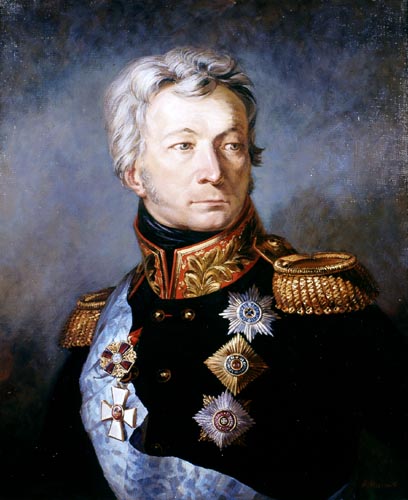Russian general and army commander. Born into an ancient Russian noble family, Tormasov began his career as a page at the imperial court in February 1762 and enlisted as a lieutenant in the Vyatka Infantry Regiment on 13 March 1772. He was promoted to captain in May 1772 and served as adjutant to Count Bruce, who was appointed commander of the Finland Division in 1774. Tormasov became lieutenant colonel and commander of the Finland Jäger Battalion in 1777. He served in the Crimea in 1782-1783 and commanded the Aleksandria Light Horse Regiment in 1784. From 1788 to 1791, he participated in the Russo- Turkish War, commanding a cavalry brigade that remained in reserve at Ochakov. Tormasov was promoted to brigadier general on 5 April 1789 and to major general on 1 April 1791. He distinguished himself at Babadag and Macin.
From 1792 to 1794, Tormasov served against the Polish insurgents, fighting at Vishnepol, Mobar, Warsaw, Maciejowice, and Praga. He was appointed chef (colonel proprietor) of the Military Order Cuirassier Regiment on 14 December 1796 and promoted to lieutenant general on 18 February 1798. However, Tormasov had an argument with Tsar Paul in 1799 and was discharged from the army on 23 July 1799. He returned to service on 28 November 1800 and was restored as chef of the Life Guard Horse Regiment on 18 December. Two days later, he was appointed commander of the Life Guard Horse Regiment. Tormasov was promoted to general of cavalry on 27 September 1801 and enjoyed a rapid succession of promotions, including to cavalry inspector of the Dniester Inspection on 23 July 1801 and cavalry inspector of the Lifland Inspection on 20 February 1802.
After briefly retiring in late 1802, Tormasov became military governor of Kiev on 7 February 1803. In 1804 he was awarded an estate in the Courland gubernia (province), and in 1805 he began organizing the Army of the Dniester against the Turks. He took a prolonged furlough because of poor health in 1806. After recuperating, Tormasov was appointed military governor of Riga on 28 March 1807 but retired again because of poor health that December. After the death of his wife, Tormasov returned to the army on 21 June 1808 and was appointed commander in chief of the troops in Georgia and the Caucasus in September 1808 during the Russo-Turkish War.
Tormasov secured the Russian administration in the Transcaucasia, defeating several Persian raids into Georgia and launching a successful offensive against the Turks in western Georgia. Simultaneously, he forced the remaining independent Georgian principalities, including the Kingdom of Imereti, into submission to Russia. He captured the fortresses of Poti and Akhaltsikhe and negotiated with the Persians at the fortress of Askoran in early 1810. He crushed the Persian Prince Abbas Mirza at Migri and Akhalkalaki in September 1810. During October, November, and December, Tormasov suppressed an uprising in Daghestan, then engaged King Solomon of Imereti at Akhaltsikhe and prevented a Turkish invasion of southern Georgia. Tormasov was appointed commander in chief of the 3rd Reserve Army of Observation in Volhynia on 27 March 1812.
During the Russian campaign of 1812, Tormasov engaged Austrian and French troops at Brest, Kobryn, and Gorodechnya. He took command of the 2nd Western Army after Prince Peter Bagration’s death in late September, but he arrived at the camp at Tarutino after the two Russian armies were merged. Tormasov thereupon assumed command of the main Russian forces, excluding the advance guard. In November, he fought at Maloyaroslavets and Krasnyi, and pursued the French to Vilna. In early 1813 he briefly commanded the Russian army after Field Marshal Mikhail Kutuzov’s death and took part in the Battle of Lützen during the spring campaign in Germany. However, he had to leave the army because of poor health, and, on being appointed a member of the State Council, he returned to St. Petersburg. He became military governor of Moscow on 11 September 1814 and was awarded the title of Count of the Russian Empire on 11 September 1816. Tormasov died on 25 November 1819 and was buried in the Don Monastery in Moscow.
References and further reading Mikaberidze, Alexander. 2005. The Russian Officer Corps in the Revolutionary and Napoleonic Wars, 1792-1815. New York: Savas Beatie.
